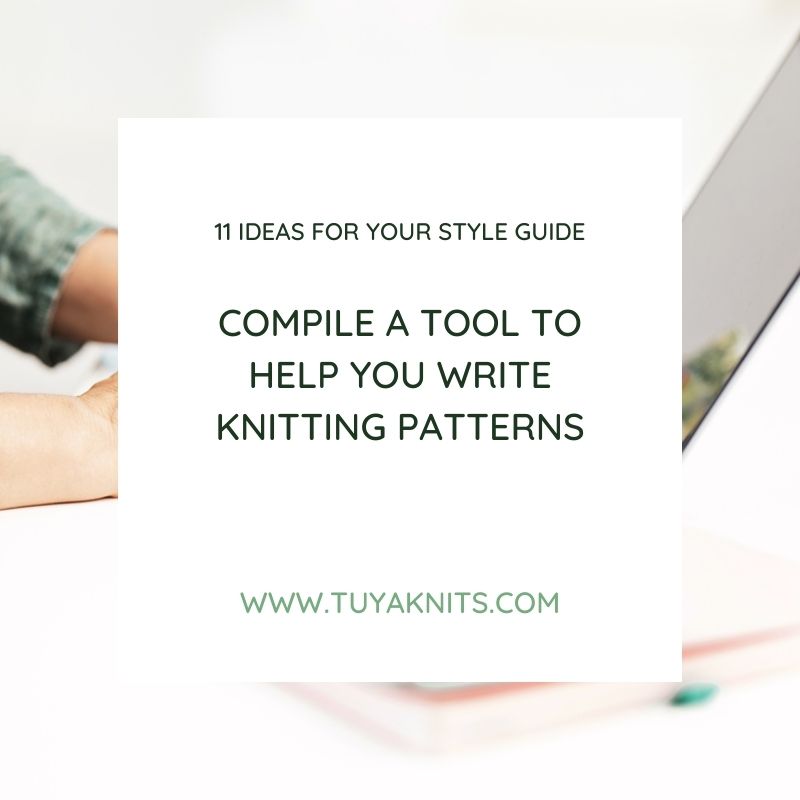Myös saatavilla|Also available in: Suomi (Finnish)
Have you ever found it hard to remember every piece of essential information you should include in your knitting patterns? Does your tech editor keep reminding of a certain detail you have a habit to forget? A style guide is a tool that helps a knitwear designer to remember all those pesky details of pattern writing. Here I have listed 11 ideas you could consider while creating a style guide for your knitting patterns.
How to be more organized as a pattern writer?
Being a highly organized pattern writer could be hard especially if you’re just starting out as a knitwear designer. However, you could help yourself in achieving a more organized writing flow by complying a personal style guide or style sheet for your patterns. A style guide is a document that includes necessary information on how to write and present your patterns.
Ideas for topics you could include in a style guide for your patterns
There are no set rules though, a style guide could be as general or as detailed as you would like it to be. It could include only the most important features or most everything you think is relevant for how you want your patterns to be. Here, I have compiled a list of items to consider for creating a style guide, and you could make up more details as you go. You can go through these elements step by step and define, how you want everything to be.
1. GENERAL REMARKS
- Fonts & font sizes
- Page numbering
- Placement of the pattern elements
- Which systems of measurements you want to use
- Use of terminology
2. STRUCTURE OF THE PATTERN
- Define which sections you want to have in your patterns
- Order of sections
- Placement of schematics, charts, and photos
3. YARN REQUIREMENTS
- Number of balls/skeins/hanks
- Yarn weights
- Fiber contents
- Information on shades used
- Yardages of required yarns in relevant systems (metric, imperial)
4. NEEDLES
- Needle sizes
- Needle types
5. OTHER TOOLS
- List all other tools
6. SIZING INFORMATION
- Define which system(s) of measurements you want to include
- Naming of the sizes
- Define how many sizes you want to have for each knitwear category
- Define which measurements are given in each knitwear category
- Define how the measurements should be rounded
- If more than one system of measurements is used, define how they should relate to each other: are the measurements measured based on one system and then converted to the other; or are all measurements calculated based on corresponding gauge information for that system
7. GAUGE
- Define area for which gauge is given
- Define which details are included in gauge information (needle size, stitch pattern(s), worked flat or in the round, measured before or after blocking)
- If there are cables or other stitch patterns which makes it hard to count stitches, you can give the width of a relevant section and the stitch count for that
8. LIST OF ABBREVIATIONS
- Comprehensive list of abbreviations in alphabetical order & corresponding explanations
- Recommended order for abbreviations (usually alphabetical is recommended)
9. INSTRUCTIONS FOR PHRASING THINGS
- Here you can list examples of phrases you want to use in different situations of the pattern
10. TUTORIALS
- Define the types of tutorials you want to use
- Self-made tutorials or made by others?
11. CHARTS AND SCHEMATICS
- Symbols used in charts
- Should written instructions be included along with charts
- Style of creating schematics
- Which software used for creating charts and schematics
An ever-evolving style guide
As said earlier, there are no set rules for a style guide as long as it is accurate, clear and works for you. Also, the layout can be anything you like, but I would recommend having the document in electronic form as that would allow for easily sending it to your tech editor for reference.
Finally, I would like to remind you that a style guide won’t need to be a cast iron collection of rules. Rather, you could consider it as an ever-evolving collection of instructions for your evolving patterns. So, keep updating it whenever you come up with improvements or additions for your patterns. Happy designing!


Be the first to comment